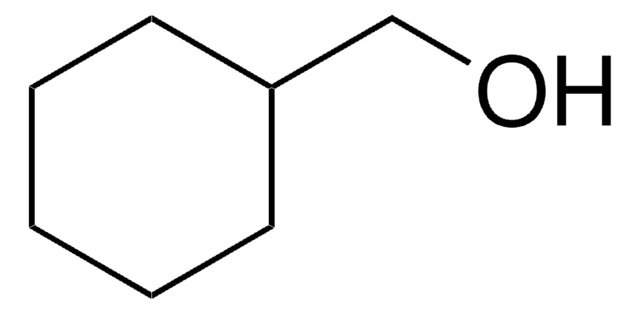PHR1229
Ethylbenzol
Pharmaceutical Secondary Standard; Certified Reference Material
Synonym(e):
Ethylbenzol, NSC 406903, Phenylethan
About This Item
Empfohlene Produkte
Qualität
certified reference material
pharmaceutical secondary standard
Qualitätsniveau
Agentur
traceable to USP 1265457
Dampfdichte
3.7 (vs air)
Dampfdruck
10 mmHg ( 20 °C)
19 mmHg ( 37.7 °C)
Analysenzertifikat (CofA)
current certificate can be downloaded
Selbstzündungstemp.
810 °F
Expl.-Gr.
6.7 %
Methode(n)
HPLC: suitable
gas chromatography (GC): suitable
Brechungsindex
n20/D 1.495 (lit.)
bp
136 °C (lit.)
mp (Schmelzpunkt)
−95 °C (lit.)
Dichte
0.867 g/mL at 25 °C (lit.)
Anwendung(en)
pharmaceutical (small molecule)
Format
neat
Lagertemp.
2-30°C
SMILES String
CCc1ccccc1
InChI
1S/C8H10/c1-2-8-6-4-3-5-7-8/h3-7H,2H2,1H3
InChIKey
YNQLUTRBYVCPMQ-UHFFFAOYSA-N
Suchen Sie nach ähnlichen Produkten? Aufrufen Leitfaden zum Produktvergleich
Allgemeine Beschreibung
Anwendung
Hinweis zur Analyse
Sonstige Hinweise
Fußnote
Empfohlene Produkte
Signalwort
Danger
H-Sätze
Gefahreneinstufungen
Acute Tox. 4 Inhalation - Aquatic Chronic 3 - Asp. Tox. 1 - Flam. Liq. 2 - STOT RE 2
Zielorgane
hearing organs
Lagerklassenschlüssel
3 - Flammable liquids
WGK
WGK 1
Flammpunkt (°F)
71.6 °F - closed cup
Flammpunkt (°C)
22.0 °C - closed cup
Hier finden Sie alle aktuellen Versionen:
Besitzen Sie dieses Produkt bereits?
In der Dokumentenbibliothek finden Sie die Dokumentation zu den Produkten, die Sie kürzlich erworben haben.
Kunden haben sich ebenfalls angesehen
Unser Team von Wissenschaftlern verfügt über Erfahrung in allen Forschungsbereichen einschließlich Life Science, Materialwissenschaften, chemischer Synthese, Chromatographie, Analytik und vielen mehr..
Setzen Sie sich mit dem technischen Dienst in Verbindung.












